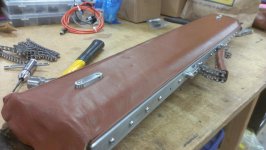ECF........stop embarrassing yourself with your pathetic ignorant opinions about cue-making.......you speak as if you've actually accomplished anything in life to accredit you in wood crafting.......let alone pool cues
Your remarks are reminiscent of someone looking to ague about something they have absolutely little understanding about......ECF might play a great game of pool but that hardly qualifies him to express such expert opinions about pool cue construction......it's moronic posts such as his that keeps the Forum entertaining and depressing concurrently.
Mr. Stroud, on behalf of pool cue entusiasts everywhere, thank you for your contributions and please forgive the antics and mindless utterings from some highly opinionated Azer who has so much to still learn about cue-making but with his mindset, that might be unattainable.
Matt B.
Actually I'm a mediocre pool player, but an accomplished engineer. I understand a lot about mechanical joints, materials properties, tolerances, machining and physics. I had, when I was 20, more cuemaking work than I could handle. I'm not going to say that my cues were the greatest made, but I'm betting you have no cuemaking experience from which to throw stones. Maybe I'm wrong, maybe I'm talking to the ghost of Gus.
I really don't understand your vitriol. Two accomplished cuemakers have responded very civilly to me. Mr. Stroud explained why he likes the radial from a cuemaking point of view. I don't necessarily agree with all of his claims, but he has defended it and I can accept that.
You have stated that the best playing cues have ivory joints. You have provided no evidence of this (besides your opinion and anecdotal evidence). You fail to give any real explanation for your statements, yet you attack someone who has given at least some credentials.
You seem like a very insecure person.
Here are some more of my credentials, feel free to list yours:
-Over a decade working as a mechanical engineer in the aerospace industry, specializing in machining and fastening major structural engineering components.
-Hobbyist cuemaker from 1995-2003. I say hobbyist because I never intended on making a career out of it. I taught myself how to make cues without videos, books or tutelage. I did this by studying, testing, and trial and error.
-Hobbyist knifemaker from 2000-present. Again, I have no intentions of making a career out of this. Again, I taught myself how to do this. I prefer to make folding knives because I enjoy designing and making the mechanisms.
-I designed and assisted in building a custom motorcycle frame. My brother did the welding, we machined the parts. This is a one-of-a-kind brushed stainless steel frame for which we fabricated every part except the springs/shocks.
-I've designed and built custom cue cases from leather and wood. One of my cases was seen by John Barton and he said it was the most beautiful case he had seen in a long time. This case was bent wood and leather. I have had offers to buy that case and the leather/stainless steel case I made. I've attached an in-progress photo of that.
So...what are your qualifications?
